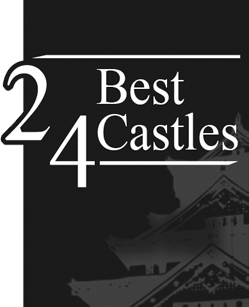Designed by Ii Naomasa following the decisive Battle of Sekigahara in 1600, Hikone was built on a strategically important point overlooking the traffic on Lake Biwa and the intersection of the vital Tosando and Hokkoku-kaido routes. The completed castle had the Honmaru at the center of the 136m summit, the Nishi-no-maru and Kannondai in the west, and the Taiko-maru and Kane-no-maru to the east. Hikone’s National Treasure designated tenshu was recycled from the upper three floors of Otsu Castle, destroyed during a Sekigahara campaign related siege. It is richly decorated with golden metallic fittings, lacquer work, and gabled roofing eves called hafu. White plaster walls cover the upper sections, with shitami-itabari protective wood paneling on the lower sections. Hikone Castle’s keep is rare in that it features 18 kato-mado, decorative arched window devices usually only featured on the uppermost floors of other castles. The top floor is furnished with a decorative balcony railing as a formality only and was not intended for actual use.




 Access
Access
 Address
Address
 Official Site Link
Official Site Link